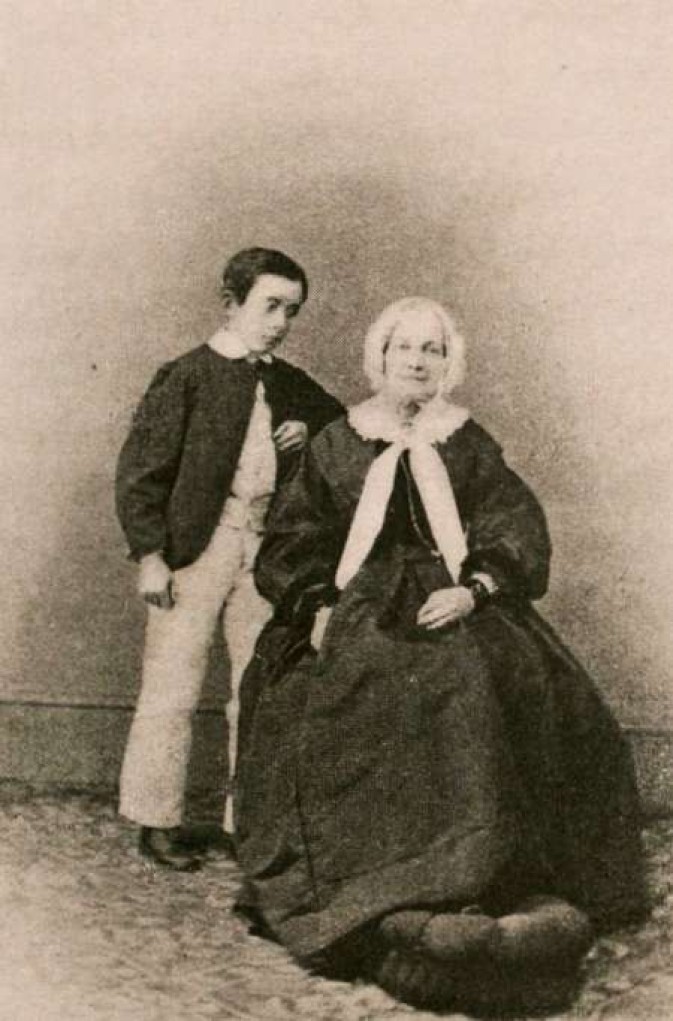Lefkada’s Hearn: Europe reclaims its literary ‘lost son’
BY DAMIAN FLANAGAN
SPECIAL TO THE JAPAN TIMES
OCT 10, 2015
Photograph: An age before Japan Hearn lived with his Irish great-aunt during the 1850's
The Greek island of Lefkada, rising from the Ionian Sea south of Corfu, is famed for its white beaches and vertical cliffs from which the poet Sappho is said to have leaped to her death. The island is also claimed as the one of the potential sites of Homer’s Ithaca, home of the great wandering hero Odysseus.
In July 2014, a museum was opened on the island commemorating the life of its other wandering son: Lafcadio Hearn.
Patrick Lafcadio Hearn (1850-1904) — named after Lefkada itself, but better known in Japan by his adopted name “Yakumo Koizumi” — is regarded by many as one of the greatest Western interpreters of Japan. Indeed, his voluminous essays about the island nation and his adaptation of ghost stories (“Kwaidan”) have been repeatedly translated into Japanese and have iconic status in the literary canon. Two museums — one in the town of Matsue on the Japan Sea coast and another in the town of Yaizu in Shizuoka Prefecture — are dedicated to celebrating his achievements and the 14 years he spent in Japan.
Hearn has been treasured in Japan for many years, but the opening of a museum in Lefkada, his birthplace, represents a new chapter in a remarkable story of his worldwide rediscovery.
In July, on the other side of Europe, the Lafcadio Hearn Memorial Gardens were opened in Ireland, in the coastal town of Tramore, County Waterford — a place where Hearn spent many of his childhood holidays. The opening was attended by the Japanese ambassador and Hearn’s great-grandson, Professor Bon Koizumi.
Indeed, across Ireland this month — in Dublin, Waterford, Galway and Mayo — Hearn is being introduced as a lost Irish literary son to the Irish themselves through an exhibition, live performances and a series of lectures entitled “Coming Home: The Open Mind of Patrick Lafcadio Hearn.”
But was Hearn Greek or Irish? In fact, several other countries also have strong claims to him, including England, America and Japan. Hearn was born the son of a Greek mother and an itinerant Irish father, a surgeon in the British army, who was briefly stationed on Lefkada when it was governed by the British.
Hearn was conceived out of wedlock and his parents quickly married before having the union later annulled, abandoning the child to the care of his paternal great-aunt in Ireland. Hearn never saw his mother again and his father remarried and moved to India.
Hearn was sent to boarding school at Ushaw College in England, but at the cusp of adulthood suffered two traumatic events: first he was blinded in one eye by a freak school accident and later his great-aunt’s wealth — which Hearn expected to inherit — was suddenly lost when she offered it as collateral for a relation who went bankrupt. Hearn was sent to the care of a former maid in London and soon emigrated to America, where he began his career as a reporter in Cincinnati, covering the roughest parts of the city.
Hearn moved on to New Orleans and steeped himself in the Creole culture, writing a cookbook, collecting songs and learning patois, as well as translating French literature and publishing a collection of Chinese ghost stories. He then moved to the French West Indies for two years, about which he published a travelogue, and published two novellas before embarking to Japan in 1890.
In Japan, too, Hearn quickly immersed himself in the culture, assuming a teaching job at the Normal School in Matsue and, within only a few months of arriving, marrying his second wife Setsuko.
Throughout his time in Japan, Hearn wrote prolifically, producing a new book every year, including such classics as “Glimpses of an Unfamiliar Japan’ (1894) and ‘Kokoro’ (1896). He fathered four children and assumed both Japanese citizenship and a Japanese name.
Famous in Europe and America in his lifetime, Hearn began to fall into obscurity after his death, though from the early Showa Era (1926-89) acquired a reputation in Japan as his works were published in Japanese. In the last 15 years, America has led the way in the rediscovery of Hearn’s fascinating reportage with several volumes devoted to his sketches of life in New Orleans and Martinique being republished.
“But if Hearn had remained in America, I would never have devoted years of my life to writing his lifestory,” reflects Irish scholar Paul Murray, whose 1993 biography, “A Fantastic Journey” helped kickstart a worldwide Hearn renaissance — Murray believes Hearn’s texts about Japan are still some of the most insightful ever written about the country.
It is long overdue for Hearn to claim his rightful place in the pantheon of Irish literary greats — it’s possible he would have played an important role in the Irish Literary Revival had he stayed in Ireland. Indeed it is the very folk tales and ghost stories recounted to Hearn while growing up in the wilds of Ireland’s Connacht Province that would later fuse with his appreciation of similar Japanese and Chinese tales. In an age of high-handed imperialism, Hearn took a profoundly anti-establishment Irish sensibility and questioning curiosity with him when he traveled abroad.
In 1904, Hearn died prematurely of heart failure at the age of 54 in Tokyo, just as he was contemplating making a return visit to London for the first time in more than three decades. Now he is finally being reclaimed by Europe, as fans across the world begin to appreciate just how far-reaching and ahead-of-his-time this visionary Irishman actually was.
Damian Flanagan is the author of “Yukio Mishima,” published by Reaktion Books, and “Natsume Soseki: Superstar of World Literature,” published in Japanese by Kodansha International.
